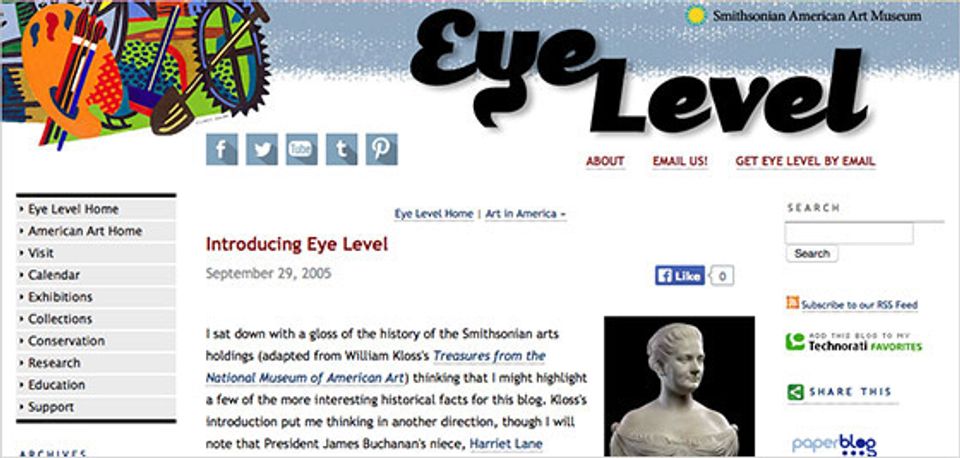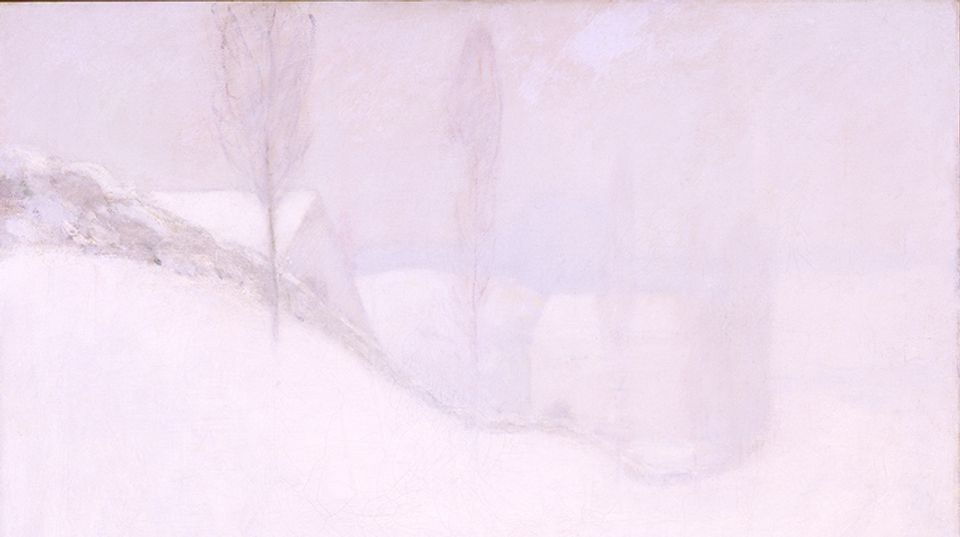

Ten years ago, November 29, 2005 to be exact, SAAM launched Eye Level, the first museum blog at the Smithsonian. It's given us the ability to tell stories and show people the museum from the inside out. We sat down with Jeff Gates, the blog's managing editor and lead producer of new media initiatives at American Art, for an eye-opening look at the genesis of Eye Level.
Eye Level: Let's open our flip phones and travel back to 2005. Eye Level was the first Smithsonian museum to have a blog. How did this come about? What was in the air?
Jeff Gates: I first proposed doing a blog to our Public Affairs department in 2002. I had been blogging personally since 2001 and thought it would be a great way to promote our museum. But it was premature; blogging was just beginning to catch on. Two years later, I had two new bosses, Mike Edson and Joanna Champagne. I pitched the idea once again. Blogging was becoming more mainstream and both were very familiar with the web and saw a blog's potential. Our website, at this point, was fairly static, meaning the pages we developed were informative but were rarely updated. The challenge was developing a workflow that would allow for this constant flow of new content.
EL: Did you have to pull teeth or was everybody on board?
JG: No, no teeth were lost in the process, I'm glad to say. However, you have to remember, this was a new medium for museums in 2005 and few outside the blogosphere knew what it entailed. So, we had to be very strategic in how we sold the idea. At the same time, SAAM had been closed for a multiyear renovation and a date of mid 2006 had been set to reopen. And everyone was focused on our reopening. I put together a PowerPoint that explained what a blog was: how, as a content management system it allowed for new stories whenever we wanted. It also allowed for comments. Commenting was new to the Net and very new to museums. Many of us were advocating for a different relationship with our visitors and online readers, one that was less hierarchical and more interactive. We took our time pitching the idea and it paid off. We got the green light.
EL: In your opinion, what makes a good blog post?
JG: My first reaction is to respond by saying, "What makes great writing?" I'm constantly asking that. Good writing is a key component. But, then one must consider the context of the medium. Our blog posts are written in a more informal voice than, say, one of our more traditional publications. This fits part of our museum's strategy to make American art accessible to everyone. We want to encourage a conversation with our viewers. In addition, it allows our curators to tell the stories of our artworks and the exhibitions in which they appear.
In the past ten years our writers are now coming from just about all departments in the museum. Some are seasoned writers; but some are new. So, I put together a handout on what makes a good blog post. I still use that today. These aren’t strict rules, just guides. Every point focuses on good writing.
EL: Ten years ago, people used to comment. Then they shared. Now they "like" posts thanks to a Facebook link. How has social media aided the blog world?
JG: The Internet is now much more interconnected. And that presents both a challenge and opportunities. You are correct, people used to comment a lot more on our blog posts than they do now. Now, they share those with others on Facebook, via Twitter, Tumblr, and Pinterest amongst others. The conversations are no longer contained just within our blog. They now spread out using any number of these platforms. This wide network of connections is a boon to everyone and certainly Eye Level. The other aspect of this interconnection is the syndication of our blog posts on other sites. Our stories are posted simultaneously on other blogs around the world. As an example, over 5,000 people per month read our content on a French-based culture blog.
EL: What is the role of storytelling in museums today, and do you think the blog is a way of telling those stories?
JG: Every single artwork in SAAM's collection has a story to tell —a context and narrative that makes the piece and the artist who created it interesting. More importantly, American art reflects American's experiences, from colonial times, through the Civil War, the 20th century, and to the present. The stories are both our history and our lives. So, yes, storytelling is an important part of our engagement with our visitors, both within our galleries and online. Eye Level has become an important conduit of these stories. And as part of our museum's overall strategy, its informal structure attracts a large and diverse group of people to the blog.
EL: Forget the flip phone. It's crystal ball time. What's next for Eye Level as the blog enters its second decade?
JG: I'm not a soothsayer. But I'm an observer, constantly looking at ways content is delivered on the Web and how we can leverage those trends to further the mission of the museum. Blogging was one of the first forms of social media. And it remains a valuable tool. Valuable and interesting content is what's really important, no matter how we deliver it. That being said, the development of new delivery formats always shifts the strategy. And we use many here at SAAM. When Twitter came out, many said blogging was dead. Actually, its role just changed. Originally, it was a method for putting out timely and, often, short posts. Twitter took that role and expanded it. Then there was Facebook, Tumblr, and Pinterest. In the last ten years I would say blogging has gone from the quick to the reflective. Tweeting is to react. Facebook and Pinterest is the share, and blogging is to reflect. That's the role of Eye Level here at SAAM. It allows us to post constant narratives about our artworks, our research, our public programs, and our education outreach. Ten years ago, our website was static. Now it's much more dynamic and our ability to constantly create new content has become an important part of the museum. That will never change, whether it's called a blog or something else.
















